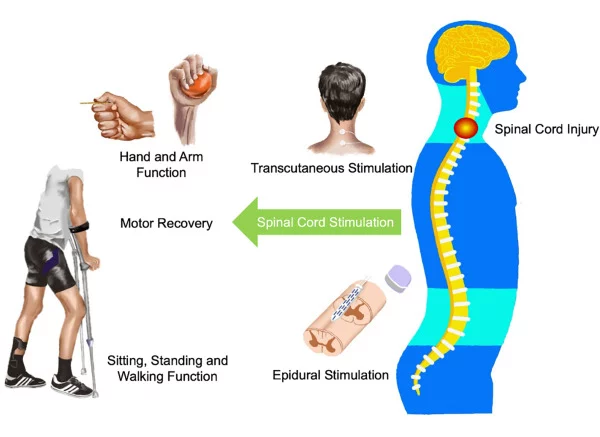Researchers at the École Polytechnique Fédérale de Lausanne (EPFL) have developed a spinal implant technology using a cyborg device, which stimulates the nerves and helps paralyzed patients regain movement. Recently, experimental results in mice showed that this device could help restore walking ability. This marks an important advance in the field of neurofunctional recovery, opening up new treatment possibilities for individuals with spinal cord injuries.

According to a statement from EPFL in 2024, the research team used an implantable device that stimulates the spinal cord nerves of mice through electrical signals from electrodes implanted in the spine. Initial experiments showed that when the paralyzed mice were implanted with this device, they could automatically move their legs when placed on a treadmill. “This is the first time a simple device has enabled mice to walk again without causing any negative reactions from the body.” (Source: EPFL, 2024).
This technology works by mimicking the brain’s role in transmitting neural signals, helping to reactivate damaged spinal cord nerves. “We hope this technology will not only help paralyzed individuals regain mobility but may also be applicable to other neurological diseases.” (Dr. Pierre-Michel L., EPFL, 2024).
The research team also mentioned that the implant could remain in the human body for up to 10 years before needing replacement. This not only provides opportunities for paralyzed individuals but could also improve their quality of life over many years.
Previous experiments had shown that using electrodes and chemicals implanted into the spine could stimulate the nerves and help mice walk. However, this is the first time scientists have demonstrated that a simple device can help animals walk without triggering negative reactions from the body. “We are hopeful that this technology can soon be applied to humans in the near future.” (Dr. Pierre-Michel L., EPFL, 2024).
The results from the mouse experiments bring great hope for treating spinal cord paralysis in humans. Although there are still technical challenges and clinical trials to be conducted, with the positive initial outcomes, this technology could be widely applied to treat neurological diseases in the future.
Pierre-Michel L., École Polytechnique Fédérale de Lausanne (EPFL), “Cyborg Spinal Implant Technology Helps Paralyzed Patients Walk,” Research Report, 2024.
Through these advanced studies, scientists hope to help paralyzed individuals return to normal life with the ability to move, thus opening up new treatment opportunities for neurological diseases.


HPX24h > Science > New Hope from Cyborg Spinal Implant Technology for Paralyzed Patients
Top Reads from This Category
Science
AI Can Simulate Evolution and Create Proteins – A New Opportunity for Breakthrough Medical Therapies
Science
Discovery of a New Stem Cell: A Major Advancement in Creating Human Organs
Science
The Science of Measuring Biological Age: New Discoveries About the Aging Process
Science
New Discovery: How the Brain Manages Emotions and Memory
Science
Recreating the Mouse Brain in a Virtual World: The Future of Neuroscience
Science
A New Drug Could Treat Depression Within Just 24 Hours
Science
Extinct Black Rhinos Could Make a Comeback with Genetic Technology
Discover New Topics
Health
5 Essential Things Every Woman Should Know About Menopause
Animals
The Care of Offspring: The Reproductive Secrets of Guppies
Animals
The Way African Ants Use Venom to Paralyze Prey from a Distance
Healthy Eating
Longevity Diet: The Key to Nutrition That Helps Extend Lifespan
Health
How Losing Just 5% of Your Weight Can Reduce the Risk of Diabetes
Parenting Tips
Teaching Children Respect: Simple Tips for Parents with Kids Aged 6 to 8
Animals
Why Bedbugs Thrive Through Inbreeding
Health
Can Gray Hair Be Restored? What Science Says About Regaining Natural Hair Color
Science
Can Pregnant Women Experience Temporary Memory Loss? The Secrets Behind Brain Changes During Pregnancy
Parenting Tips
Discover How Japan’s Education System Creates Self-Disciplined, Responsible Students Without the Need for Pressure
Fitness
Why Do You Get Headaches After Exercise? Causes, Remedies, and Effective Prevention
Space
Could Our Universe Have Collided With Another Universe Billions of Years Ago?
Animals
Bee Wax Bust of Nefertiti: The Perfect Fusion of Art and Nature